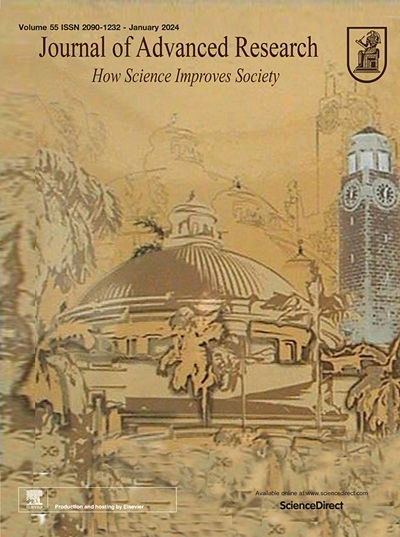Tussilagone attenuated cigarette smoke-induced chronic obstructive pulmonary disease through regulating Nrf2 and NF-κB/NLRP3 inflammasome via directly targeting cysteine 434 of KEAP1
IF 11.4
1区 综合性期刊
Q1 MULTIDISCIPLINARY SCIENCES
引用次数: 0
Abstract
Introduction
Chronic obstructive pulmonary disease (COPD) represents a significant global health challenge, characterized by substantial morbidity and mortality rates. In traditional Chinese medicine (TCM), Farfarae Flos (FF) has been widely utilized as a therapeutic agent for COPD. However, its specific bioactive compounds and the underlying mechanisms are unclear.Objectives
This study aims to identify bioactive constituent of FF against COPD and illustrate its therapeutic target and mechanism.Methods and Results
In this research, a high-throughput screening on constituents of FF was conducted, leading to the identification of a potent anti-COPD lead, tussilagone (TUS). Utilizing biotin-labeling approach, Kelch-like ECH-associated protein 1 (KEAP1), the ubiquitin E3 ligase of nuclear factor erythroid 2-related factor 2 (Nrf2), was identified to be the direct target of TUS. Mechanistically, TUS activated KEAP1-Nrf2 axis by covalent modification of cysteine 434 (Cys434), a novel high-reactivity cysteine of KEAP1. TUS-mediated Nrf2 activation further suppressed the activation of nuclear factor kappa-B (NF-κB) and NOD-like receptor thermal protein domain associated protein 3 (NLRP3) inflammasome, consequently attenuating lung inflammation in COPD.Conclusion
TUS was identified as the bioactive constituent of FF against COPD, which directly targeted Cys434 of KEAP1. KEAP1 was proven to be a pharmacological target for the treatment of COPD, and Cys434 was identified to be the first highly reactive cysteine in Kelch domain of KEAP1. TUS inhibits lung inflammation by regulating Nrf2 and NF-κB/NLRP3, which is the mechanism of FF against COPD

Tussilagone通过直接靶向KEAP1的半胱氨酸434,调控Nrf2和NF-κB/NLRP3炎性体,减轻香烟烟雾诱导的慢性阻塞性肺疾病
慢性阻塞性肺疾病(COPD)是一项重大的全球健康挑战,其特点是发病率和死亡率都很高。在中医中,Farfarae Flos (FF)已被广泛用作慢性阻塞性肺病的治疗剂。然而,其具体的生物活性化合物和潜在的机制尚不清楚。目的鉴定FF抗COPD的生物活性成分,阐明其治疗靶点和作用机制。方法与结果本研究对FF的成分进行了高通量筛选,鉴定出一种有效的抗copd先导物——tussilagone (TUS)。利用生物素标记方法,Kelch-like ECH-associated protein 1 (KEAP1),核因子红细胞2相关因子2 (Nrf2)的泛素E3连接酶被确定为TUS的直接靶点。在机制上,TUS通过对KEAP1的一种新型高反应性半胱氨酸——半胱氨酸434 (Cys434)的共价修饰激活了KEAP1- nrf2轴。tus介导的Nrf2激活进一步抑制核因子κ b (NF-κB)和nod样受体热蛋白结构域相关蛋白3 (NLRP3)炎性体的激活,从而减轻COPD患者的肺部炎症。结论经鉴定,tus是FF抗COPD的生物活性成分,其直接靶向KEAP1的Cys434。KEAP1被证明是治疗COPD的药理学靶点,而Cys434被鉴定为KEAP1 Kelch结构域的第一个高活性半胱氨酸。TUS通过调节Nrf2和NF-κB/NLRP3抑制肺部炎症,这是FF抗COPD的机制
本文章由计算机程序翻译,如有差异,请以英文原文为准。
求助全文
约1分钟内获得全文
求助全文
来源期刊

Journal of Advanced Research
Multidisciplinary-Multidisciplinary
CiteScore
21.60
自引率
0.90%
发文量
280
审稿时长
12 weeks
期刊介绍:
Journal of Advanced Research (J. Adv. Res.) is an applied/natural sciences, peer-reviewed journal that focuses on interdisciplinary research. The journal aims to contribute to applied research and knowledge worldwide through the publication of original and high-quality research articles in the fields of Medicine, Pharmaceutical Sciences, Dentistry, Physical Therapy, Veterinary Medicine, and Basic and Biological Sciences.
The following abstracting and indexing services cover the Journal of Advanced Research: PubMed/Medline, Essential Science Indicators, Web of Science, Scopus, PubMed Central, PubMed, Science Citation Index Expanded, Directory of Open Access Journals (DOAJ), and INSPEC.
 求助内容:
求助内容: 应助结果提醒方式:
应助结果提醒方式:


